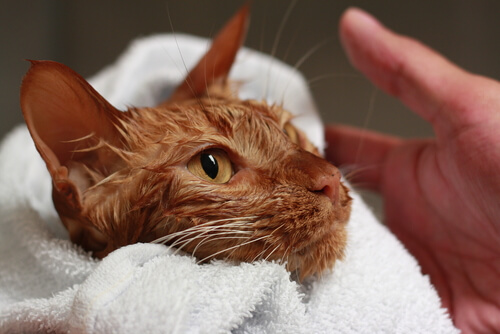A Simple Guide on How to Bathe Your Cat Safely


Written and verified by the lawyer Francisco María García
As everyone knows, cats are very clean animals. It’s also well-known that cats are afraid of water. So today, let’s take a look at how to bathe your cat safely.
Their ability to use their teeth and tongues to clean themselves is one of their main traits and also a great advantage in having a cat.
However, there are times they get dirty and aren’t able to remove the dirt themselves. If this happens, their owners might need to give them a helping hand.
So, it’s very important to get them used to water from an early age (ideally within the first two months) so that they can see that it’s completely normal. It’s important to only use specially designed cat shampoo, and to never use conditioner.
Human shampoo is not recommended for cats. Among other reasons, this is because it contains chemicals that can be harmful to their skin.
How to bathe your cat safely

If you want to bathe your cat safely, it’s best to do it in the sink, as it’s the perfect size and shape.
- The best thing to do is to run about an inch of lukewarm water, and try to get him used to the sound of the faucet.
- It’s best to stay relaxed, and to try to calm your pet by stroking it and talking to it soothingly.
- If you want to bathe your cat, it’s best to choose a moment when he’s calm. It’s also a good idea to play with him beforehand, so that he burns plenty of energy and is happy and content.
- Before bathing him, give him a good brush to get rid of any knots or loose hairs. This is particularly important if your cat is long-haired.
- Try to remember to put some cotton wool in his ears so that water doesn’t get in them. This will help prevent infections.
- Before running the water, you should put down a bath mat so your cat won’t slip.
- To make the bath safe for your cat, you shouldn’t run more than about 4 inches of water. You also need to make sure it’s not too hot – lukewarm is the ideal temperature.
Further advice on how to bathe your cat
- The best way to wet your cat’s fur is by using a small hand-held shower.
- Once his fur is wet, apply some cat shampoo (human shampoo will dry out its skin) and rub it in, working in the direction of the hairs.
- Be careful not to get his face or ears wet.
- Rinse his fur thoroughly, making sure to wash all the shampoo off. Shampoo residue could irritate his skin, and can even make his fur sticky, attracting dust and dirt.
- If you want to wash his face, take a damp cloth and wipe it gently. If his face is really dirty, we would recommend diluting some shampoo in water. But remember, be careful not to get any in his eyes.
Drying your cat
Once they’re clean and you’ve drained the water, it’s time to dry your cat. Wrap them in a towel, and take them to a warm room to dry them off. If your cat isn’t afraid of loud noises, you could even use a hairdryer.
After the bath, you can also trim or file their nails. So that your pet associates baths with a positive experience, you should make sure you have a reward ready for him once you’ve finished drying him off. Pets love rewards, especially if they come in the form of a tasty treat.
Alternative options for a safe bath

If your cat is scared of water, one alternative option is to give him a really quick bath.
Take your cat to the bathtub, but don’t turn on the faucet or the shower. Instead, put some lukewarm water in a bucket (98°F is ideal). Put your cat’s front legs in the bucket, holding onto his back end with one hand.
Dilute some soap in water (again, always use cat shampoo) and with the other hand use it to wet his fur. Rinse it off quickly.
With cats it’s all about being as quick as possible, so that they don’t have time to get upset. This option is best for cats that don’t particularly like baths, but still take a while to react.
The three bowl method
This method involves filling three bowls with lukewarm water. Put them in the bathtub, or even out in the garden. What’s important is to use a flat, stable surface so that they won’t get knocked over.
Fill the first and third bowls with lukewarm water, putting shampoo in the second. Holding your cat around the hips, wet his fur in the first bowl, wash him in the second, and rinse him off in the third, making sure not to get any water on his head. Because the bowls are shallower and there’s less water, your cat is less likely to get scared.
This text is provided for informational purposes only and does not replace consultation with a professional. If in doubt, consult your specialist.